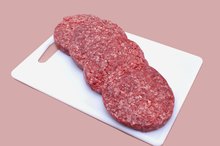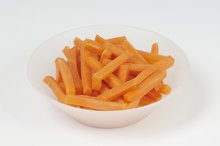Low Glycemic Foods & Cheese
The glycemic index, or GI, was developed to help people better understand how carbohydrate-containing foods influence blood sugar levels. Consuming high-glycemic index foods results in a sharp rise in your blood sugar levels and is associated with obesity, Type 2 diabetes, cardiovascular diseases and certain cancers. On the opposite end, low-glycemic index foods can help you keep your blood sugar levels more stable after eating, which is associated with a healthier body weight and improved blood cholesterol and blood sugar levels.
How the Glycemic Index is Measured
The GI value of food is measured by first giving volunteers a dose of 50 grams of pure glucose, which is assigned a GI value of 100, and measuring their blood sugar response over two hours. A serving providing 50 grams of available carbohydrates of the food to be tested is then given to volunteers, and their blood sugar levels are tested over a two-hour period. The GI value of a food corresponds to the increase in the blood sugar levels it induces compared with glucose. For example, if the blood sugar level increase of white bread corresponds to 70 percent of the response seen with pure glucose in these volunteers, white bread will be given a GI value of 70.
- The GI value of food is measured by first giving volunteers a dose of 50 grams of pure glucose, which is assigned a GI value of 100, and measuring their blood sugar response over two hours.
Cheese
Low-Glycemic Foods List
Learn More
An ounce of cheddar cheese contains only 0.4 gram of carbohydrates, which makes it impossible to measure its GI value. Volunteers would have to ingest 7.8 pounds to get the 50 grams of carbohydrates required to do the test. However, it is safe to say that because cheese has such a low carbohydrate content, it shouldn't significantly influence your blood sugar levels. The GI value of cheese should correspond to zero, making it a good food to include in your low-glycemic-index diet.
- An ounce of cheddar cheese contains only 0.4 gram of carbohydrates, which makes it impossible to measure its GI value.
- The GI value of cheese should correspond to zero, making it a good food to include in your low-glycemic-index diet.
Other Foods Without a Glycemic Index Value
Other foods with a very low carbohydrate content, such as meat, eggs, avocado and salad vegetables, are in the same situation. The glycemic index is only designed to measure the glycemic response following the consumption of carbohydrate-containing foods. Considering the lack of carbohydrates in these foods, their GI can be estimated to be zero, or very close to zero, making these foods suitable for a low-glycemic-index diet.
Including Cheese in Your Low-Glycemic-Index Diet
Glycemic Index of Cheerios
Learn More
Cheese can be paired with many low-glycemic-index foods to enhance the taste and diversity of your low-glycemic diet. For example, you can add cheese to a mushroom frittata at breakfast, serve cheese with a vegetable soup or salad at lunch, enjoy cheese with an apple, grapes or nuts for a snack or sprinkle cheese over your whole-grain pasta for dinner. All these foods have low GI values and can be part of your healthy low-glycemic meal plan.
Related Articles
References
- American Journal of Clinical Nutrition: International Table of Glycemic Index and Glycemic Load Values
- Ojo O, Ojo OO, Adebowale F, Wang XH. The effect of dietary glycaemic index on glycaemia in patients with type 2 diabetes: A systematic review and meta-analysis of randomized controlled trials. Nutrients. 2018;10(3):373. Published 2018 Mar 19. doi:10.3390/nu10030373
- Glycemic Index and Diabetes. American Diabetes Association
- Search for the Glycemic Index. The University of Sydney
- Zeevi D, Korem T, Zmora N, et al. Personalized Nutrition by Prediction of Glycemic Responses. Cell. 2015;163(5):1079-1094. doi:10.1016/j.cell.2015.11.001+
- Sacks FM, Carey VJ, Anderson CA, et al. Effects of high vs low glycemic index of dietary carbohydrate on cardiovascular disease risk factors and insulin sensitivity: the OmniCarb randomized clinical trial. JAMA. 2014;312(23):2531-41. doi:10.1001/jama.2014.16658.
- Vega-lópez S, Venn BJ, Slavin JL. Relevance of the Glycemic Index and Glycemic Load for Body Weight, Diabetes, and Cardiovascular Disease. Nutrients. 2018;10(10). doi:10.3390/nu10101361
- Glycemic Index Database. University of Sydney. Updated October 13, 2020
- Eleazu C. O. (2016). The concept of low glycemic index and glycemic load foods as panacea for type 2 diabetes mellitus; prospects, challenges and solutions. African health sciences, 16(2), 468–479. doi:10.4314/ahs.v16i2.15
- Foster-Powell, Kaye, Holt, Susanna and Brand-Miller, Janette. "International table of glycemic index and glycemic load values: 2002." American Journal of Clinical Nutrition. 76,:1: 5-56 (2002).
- International Carbohydrate Quality Consortium, Jenkins, D. J., Willett, W. C., Astrup, A., Augustin, L. S., Baer-Sinnott, S., … Wolever, T. M. (2014). Glycaemic index: did Health Canada get it wrong? Position from the International Carbohydrate Quality Consortium (ICQC). The British journal of nutrition, 111(2), 380–382. doi:10.1017/S0007114513003905
- Leroux, MarcusFoster-Powell, Kaye, Holt, Susanna and Brand-Miller, Janette. "International Table of Glycemic Index and Glycemic Load Values: 2002." American Journal of Clinical Nutrition. Vol. 76, No. 1, 5-56, (2002).
- Lui, S., Willett, WC, et al. "A prospective study of dietary glycemic load, carbohydrate intake, and risk of coronary heart disease in US women.." American Journal of Clinical Nutrition. 71(6):1455-61. (2001).
- Mayer-Davis, E.J., Dhawan, A et al. "Towards understanding of glycaemic index and glycaemic load in habitual diet: associations with measures of glycaemia in the Insulin Resistance Atherosclerosis Study.." British Nutrition Journal. 95(2):397-405. (2006).
- Sacks, F. M., Carey, V. J., Anderson, C. A., Miller, E. R., 3rd, Copeland, T., Charleston, J., … Appel, L. J. (2014). Effects of high vs low glycemic index of dietary carbohydrate on cardiovascular disease risk factors and insulin sensitivity: the OmniCarb randomized clinical trial. JAMA, 312(23), 2531–2541. doi:10.1001/jama.2014.16658
- Salmeron, J, Manson, JE, et al. "Dietary fiber, glycemic load, and risk of non-insulin-dependent diabetes mellitus in women.." Journal of the American Medical Association. 12;277(6):472-7. (1997).
- Vega-López, S., Venn, B., & Slavin, J. (2018). Relevance of the Glycemic Index and Glycemic Load for Body Weight, Diabetes, and Cardiovascular Disease. Nutrients, 10(10), 1361. doi:10.3390/nu10101361
- Zeevi, D. Korem N. et al. Personalized Nutrition by Prediction of Glycemic ResponsesCell. 163:(5):1079-94. November 2015.
Writer Bio
Aglaee Jacob is a registered dietitian. She has experience working with people who have diabetes, cardiovascular disease, hypertension and obesity issues. Jacob obtained a bachelor of science and a master of science, both in nutrition, from Laval University in Quebec City, Canada.









